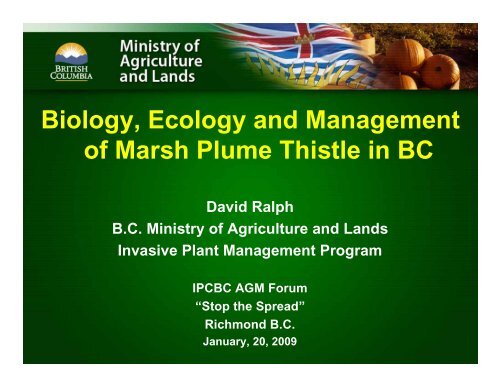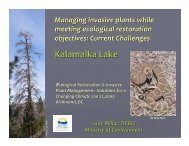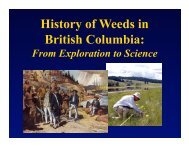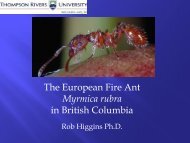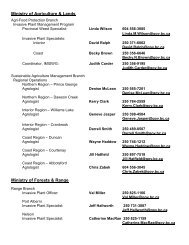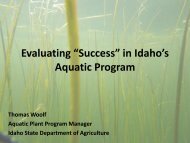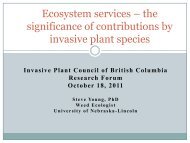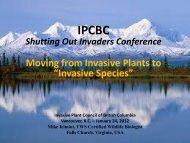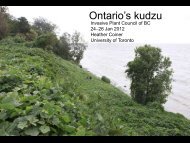Biology, Ecology and Management of Marsh Plume Thistle in BC
Biology, Ecology and Management of Marsh Plume Thistle in BC
Biology, Ecology and Management of Marsh Plume Thistle in BC
You also want an ePaper? Increase the reach of your titles
YUMPU automatically turns print PDFs into web optimized ePapers that Google loves.
<strong>Biology</strong>, <strong>Ecology</strong> <strong>and</strong> <strong>Management</strong><br />
<strong>of</strong> <strong>Marsh</strong> <strong>Plume</strong> <strong>Thistle</strong> <strong>in</strong> <strong>BC</strong><br />
David Ralph<br />
B.C. M<strong>in</strong>istry <strong>of</strong> Agriculture <strong>and</strong> L<strong>and</strong>s<br />
Invasive Plant <strong>Management</strong> Program<br />
IPC<strong>BC</strong> AGM Forum<br />
“Stop the Spread”<br />
Richmond B.C.<br />
January, 20, 2009
<strong>Marsh</strong> <strong>Plume</strong> <strong>Thistle</strong><br />
(Cirsium palustre)<br />
<strong>Biology</strong><br />
• Asteraceae Family, Cirsium<br />
genus,<br />
• 10 Cirsium sp. <strong>in</strong> <strong>BC</strong>,<br />
• 3 are non-native Douglas et al, 1998<br />
• Fibrous rooted biennial,<br />
• 1 st year, rosette, leaves<br />
covered with tangled or matted<br />
woolly hairs (tomentose)
<strong>Biology</strong> con’t<br />
• 2 nd year, bolt<strong>in</strong>g, erect<br />
slender stem, grows<br />
0.3 – 2.5 m (1-8 ft.)<br />
Stem is ribbed with sp<strong>in</strong>y w<strong>in</strong>gs
<strong>Biology</strong> con’t<br />
• Leaves are deeply segmented, hairy on the<br />
undersides, <strong>and</strong> have prom<strong>in</strong>ent woody<br />
ve<strong>in</strong>s.<br />
• Flowers, numerous, compact<br />
blossoms at end <strong>of</strong> branches<br />
near top <strong>of</strong> plant
<strong>Biology</strong> con’t<br />
• Propagates only by w<strong>in</strong>d borne seed<br />
via a parachute-like plume <strong>of</strong> hairs<br />
(pappus). Can disperse long distances<br />
• C. palustre is able to form a persistent<br />
seed-bank <strong>in</strong> the soil (Pons 1984, Grime 1979).<br />
• Fal<strong>in</strong>ska (1997) calculated that only<br />
5-10% <strong>of</strong> seeds <strong>in</strong> the seed bank<br />
developed <strong>in</strong>to seedl<strong>in</strong>gs regardless <strong>of</strong> the successional stage<br />
<strong>of</strong> the surround<strong>in</strong>g vegetation.<br />
• C. palustre achenes buried <strong>in</strong> pots had a 40% survival rate after<br />
one year. Van Leeuwen <strong>and</strong> van Breemen (1988)<br />
• Literature conta<strong>in</strong>ed no estimates <strong>of</strong> how long seed rema<strong>in</strong>s<br />
viable <strong>in</strong> the seedbank.<br />
<strong>BC</strong>MoFR
Orig<strong>in</strong>/Distribution<br />
• Native to Europe, (Sc<strong>and</strong><strong>in</strong>avia to western Mediterranean)<br />
• Collected <strong>in</strong> New Hampshire 1902 Holt, 1902<br />
• Newfoundl<strong>and</strong> 1919 Fernald 1933<br />
• Michigan s<strong>in</strong>ce 1935 <strong>and</strong> Wiscons<strong>in</strong> s<strong>in</strong>ce 1962 Johnson et al, 1962<br />
• First herbarium sample <strong>in</strong> <strong>BC</strong> from outskirts <strong>of</strong> Pr<strong>in</strong>ce Rupert<br />
<strong>in</strong> 1954,<br />
• 1992 Goat River, Hwy 16 east <strong>of</strong> Pr<strong>in</strong>ce George,<br />
• 1997 Alliford Bay south Moresby Isl<strong>and</strong> Royal <strong>BC</strong> Museum
Distribution <strong>of</strong> C. palustre <strong>in</strong> NA<br />
USDA NRCS Plants Database<br />
Distribution <strong>of</strong> C. palustre <strong>in</strong> <strong>BC</strong><br />
Douglas, et al 1998
1981 1999<br />
<strong>Marsh</strong> <strong>Plume</strong><br />
thistle<br />
spread over<br />
time <strong>in</strong> <strong>BC</strong><br />
Prepared Dec 2009<br />
<strong>BC</strong>MFR IAPP<br />
2008
<strong>Ecology</strong><br />
• The preferred habitats for <strong>Marsh</strong> <strong>Plume</strong> <strong>Thistle</strong> <strong>in</strong> North<br />
America are reported to be moist woodl<strong>and</strong>s <strong>and</strong> riparian areas.<br />
In the Robson Valley, the vast majority <strong>of</strong> sites are <strong>in</strong> the<br />
Interior cedar hemlock (ICH) biogeoclimatic zone. (Fraser, 2000)<br />
• Douglas et al (1998) report C. palustre as <strong>in</strong>frequent throughout<br />
British Columbia south <strong>of</strong> 55oN.
Habitats<br />
• In <strong>BC</strong>, moist meadows <strong>and</strong> forest open<strong>in</strong>gs <strong>in</strong> lowl<strong>and</strong> zone Douglas et al 1998<br />
• Habitat types similar to Europe, moist woodl<strong>and</strong> Moore <strong>and</strong> Frankl<strong>in</strong> 1974 , <strong>and</strong><br />
damp clear<strong>in</strong>gs <strong>and</strong> thickets Scoggan 1978<br />
Soils<br />
• In <strong>BC</strong>, field observations <strong>in</strong> the Pr<strong>in</strong>ce George<br />
<strong>and</strong> Robson Valley FS Districts, recorded that<br />
C. palustre was thought to be able to establish<br />
<strong>in</strong> all but frequently flooded or permanently pond<br />
areas. It was found grow<strong>in</strong>g <strong>in</strong>: Sanborn, email, 1998<br />
– f<strong>in</strong>e textured soils<br />
– coarse gravelly soils<br />
– bare m<strong>in</strong>eral soils (roadcuts, scalped skidtrails)<br />
– thick <strong>in</strong>tact forest floors greater than 10 cm
Associated Species<br />
• “In <strong>BC</strong>, found to be grow<strong>in</strong>g on sites <strong>in</strong> the ICH<br />
zone with the follow<strong>in</strong>g associated vegetation”<br />
Sanborn, P, email, 1999<br />
- found grow<strong>in</strong>g with sparse, low-grow<strong>in</strong>g<br />
herb cover (Cornus),<br />
- tall perennial herbs (Epilobium),<br />
- sod form<strong>in</strong>g grasses <strong>and</strong> sedges<br />
(undisturbed Festuca rubra <strong>and</strong> Carex),<br />
- broadcast-burned <strong>and</strong> raw<br />
plantations<br />
- non-forested wetl<strong>and</strong>s on<br />
raised microsites
<strong>Management</strong>:<br />
• Prevention: through Education<br />
Stop its’ Establishment – Know what it is, <strong>and</strong> where<br />
Stop the Spread - know its mechanism <strong>of</strong> spread, know its<br />
habitat <strong>and</strong> know its’ spread vectors<br />
• Manual Control - pull<strong>in</strong>g, cutt<strong>in</strong>g will stop seed production<br />
• Cultural Control – competitive species resist <strong>in</strong>vasion<br />
• Chemical Biological – judicious use <strong>of</strong> herbicides<br />
• Biological Control – develop<strong>in</strong>g/obta<strong>in</strong><strong>in</strong>g bio-agents that<br />
will establish, flourish <strong>and</strong> impact weed populations
Manual <strong>and</strong> Cultural Control<br />
- Cutt<strong>in</strong>g <strong>and</strong> pull<strong>in</strong>g/digg<strong>in</strong>g will stop/reduce<br />
or slow seed production<br />
- Competitive vegetation complex can reduce<br />
<strong>in</strong>vasion, but can it resist <strong>Marsh</strong> <strong>Plume</strong><br />
thistle <strong>in</strong>vasion?<br />
- Competitive species where disturbed soil exists or<br />
is created. It’s never a bad idea to re-vegetate
Herbicide Control <strong>of</strong> <strong>Marsh</strong> <strong>Plume</strong> <strong>Thistle</strong><br />
Tordon 22K 4.5L<br />
Tordon 22K 2.25L<br />
Gr azo n 3.7L<br />
Gr azo n 7L<br />
Tr an sl<strong>in</strong> e .83L<br />
B+2,4-D2.1L +1.0kg<br />
Ban vel 4.6L<br />
Ban vel 2.1L<br />
M+2,4-D.5L +1.5kg<br />
M+2,4-D.38L +1.1kg<br />
M+2,4-D .29L +.85kg<br />
Milesto n e .5L<br />
Milesto n e .38L<br />
Milesto n e .28L<br />
Milesto n e .25L<br />
ch eck<br />
<strong>Marsh</strong> <strong>Plume</strong> <strong>Thistle</strong> control 29 months after late June 2006<br />
treatment <strong>of</strong> am<strong>in</strong>opyralid alone <strong>and</strong> am<strong>in</strong>opyralid + 2,4-D<br />
0% 20% 40% 60% 80% 100%<br />
<strong>Marsh</strong> <strong>Plume</strong> <strong>Thistle</strong> control 29 months after late June 2006 treatment
Am<strong>in</strong>opyralid 60g a.i.<br />
(0.25 L/prod) /ha<br />
Prior to Treatment
Current Conta<strong>in</strong>ment areas<br />
<strong>in</strong> <strong>BC</strong><br />
For <strong>Marsh</strong> <strong>Plume</strong> thistle<br />
Conta<strong>in</strong>ment areas are established<br />
boundaries to identify where an<br />
<strong>in</strong>vasive species is established <strong>in</strong><br />
its’ highest density <strong>in</strong>festations.<br />
Typically, little if any management<br />
takes place with<strong>in</strong> these<br />
conta<strong>in</strong>ment areas <strong>and</strong> high<br />
priority areas for management are<br />
usually outside the conta<strong>in</strong>ment<br />
area where populations size <strong>and</strong><br />
density is low
Biological Control<br />
- Use <strong>of</strong> natural predators to control IP populations<br />
- For C. palustre there is currently no effective bioagents<br />
- M<strong>in</strong>istry <strong>of</strong> Forests <strong>and</strong> Range, Forest Practices<br />
Branch is currently carry<strong>in</strong>g out research on 2 trials<br />
seed feed<strong>in</strong>g weevil Rh<strong>in</strong>ocyllus conicus<br />
Photos; S.Turner<br />
MoFR
Biological Control con\t<br />
- one trial <strong>in</strong>vestigat<strong>in</strong>g effectiveness <strong>of</strong> R. conicus feed<strong>in</strong>g on<br />
the seeds <strong>of</strong> marsh thistle (started <strong>in</strong> 2006 with AAFC)<br />
- one <strong>in</strong>vestigat<strong>in</strong>g population thresholds started <strong>in</strong> 2008.<br />
• R. conicus first released on Nodd<strong>in</strong>g thistle (Carduus nutans) <strong>in</strong><br />
July 1984, Bridesville <strong>and</strong> <strong>in</strong> Ch<strong>in</strong>a Creek Rd, Pr<strong>in</strong>ceton <strong>in</strong> 1988<br />
• Primary agent – marsh plume thistle, Canada thistle<br />
• Secondary agent – plumeless, bull <strong>and</strong> Scotch thistles<br />
• Tertiary agent – nodd<strong>in</strong>g thistle
Biological Control con\t<br />
“There does appear some vary<strong>in</strong>g acceptability to the different<br />
habitats we put them <strong>in</strong> (a particularly cold, higher elevation<br />
dra<strong>in</strong>age has not shown establishment). However, even though<br />
we have had some sites show establishment over a couple<br />
years, the numbers are regularly decreas<strong>in</strong>g” Susan Turner, email, 2009<br />
• Terellia ruficauda, an adventive fly, which feeds on all thistle<br />
seeds, has also been found on marsh plume thistle <strong>and</strong> has<br />
been designated a secondary agent for C. palustre<br />
• Trichosirocalus horridus, root crown feed<strong>in</strong>g weevil, is a primary<br />
agent for C. palustre
History <strong>of</strong> <strong>Marsh</strong> <strong>Thistle</strong> Invasion<br />
<strong>Marsh</strong> <strong>Thistle</strong><br />
1971
History<br />
<strong>Marsh</strong> <strong>Thistle</strong><br />
1981
History<br />
<strong>Marsh</strong> <strong>Thistle</strong><br />
1997
Present<br />
<strong>Marsh</strong> <strong>Thistle</strong><br />
2001
Future?<br />
<strong>Marsh</strong> <strong>Thistle</strong><br />
Projected 2016
References:<br />
• Cirsium palustre (<strong>Marsh</strong> <strong>Thistle</strong>), Literature Search <strong>and</strong> Habitat<br />
Potential Risk Analysis. Fraser, N., March 2000<br />
• Beware this alien weed, <strong>Marsh</strong> <strong>Thistle</strong> Cirsium palustre, <strong>BC</strong>MoFR,<br />
Pr<strong>in</strong>ce George Forest Region, Prov<strong>in</strong>cial Noxious Weed Control<br />
Program, Extension publication, August 2000<br />
• <strong>Marsh</strong> <strong>Plume</strong> <strong>Thistle</strong> Abundance <strong>and</strong> Potential <strong>in</strong> the Robson Valley<br />
T.S.A. Mahoney, D., et al, March 31, 2004<br />
• B. Dr<strong>in</strong>kwater, <strong>BC</strong> M<strong>in</strong>istry <strong>of</strong> Forests <strong>and</strong> Range. Personal<br />
communication<br />
• S. Turner, <strong>BC</strong> M<strong>in</strong>istry <strong>of</strong> Forests <strong>and</strong> Range, Email communication<br />
• Illustrated Flora <strong>of</strong> British Columbia, Douglas, G., et al 1998<br />
• <strong>BC</strong> M<strong>in</strong>istry <strong>of</strong> forests <strong>and</strong> Range, Forest Practises Branch, Biocontrol<br />
Development Program website<br />
• Dwayne Brooke, (retired) <strong>BC</strong>MoF, Powerpo<strong>in</strong>t presentation<br />
• Royal <strong>BC</strong> Museum Herbarium records
Thank you<br />
for the<br />
Opportunity to<br />
Present to You Today


